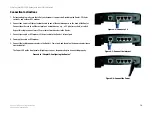
6
Chapter 2: Your Virtual Private Network (VPN)
Computer (using VPN client software that supports IPSec) to VPN Router
EtherFast Cable/DSL VPN Router with 4-Port 10/100 Switch
VPN Router to VPN Router
An example of a VPN Router-to-VPN Router VPN would be as follows. At home, a telecommuter uses his VPN
Router for his always-on Internet connection. His router is configured with his office's VPN settings. When he
connects to his office's router, the two routers create a VPN tunnel, encrypting and decrypting data. As VPNs
utilize the Internet, distance is not a factor. Using the VPN, the telecommuter now has a secure connection to the
central office's network, as if he were physically connected.
Computer (using VPN client software that supports IPSec) to VPN Router
The following is an example of a computer-to-VPN Router VPN. In her hotel room, a traveling businesswoman
dials up her ISP. Her notebook computer has VPN client software that is configured with her office's VPN settings.
She accesses the VPN client software that supports IPSec and connects to the VPN Router at the central office. As
VPNs utilize the Internet, distance is not a factor. Using the VPN, the businesswoman now has a secure
connection to the central office's network, as if she were physically connected.
For additional information and instructions about creating your own VPN, please visit Linksys’s website at
www.linksys.com or refer to “Appendix F: Configuring IPSec between a Windows 2000 or XP PC and the VPN
Router.”
Figure 2-1: VPN Router to VPN Router
Figure 2-2: Computer to VPN Router
IMPORTANT:
You must have at least one VPN Router on
one end of the VPN tunnel. At the other end of the VPN
tunnel, you must have a second VPN Router or a computer
with VPN client software that supports IPSec.













































